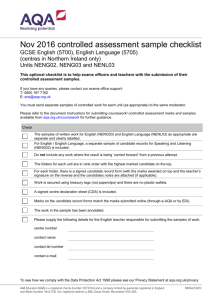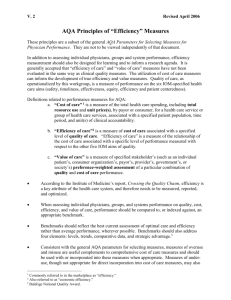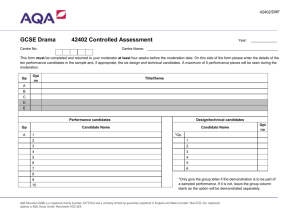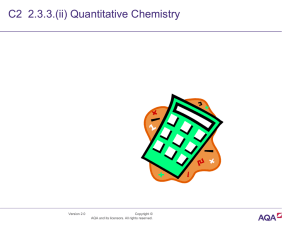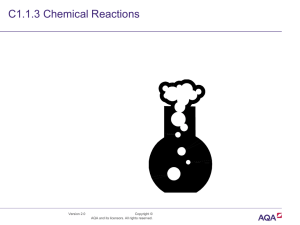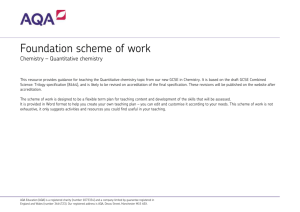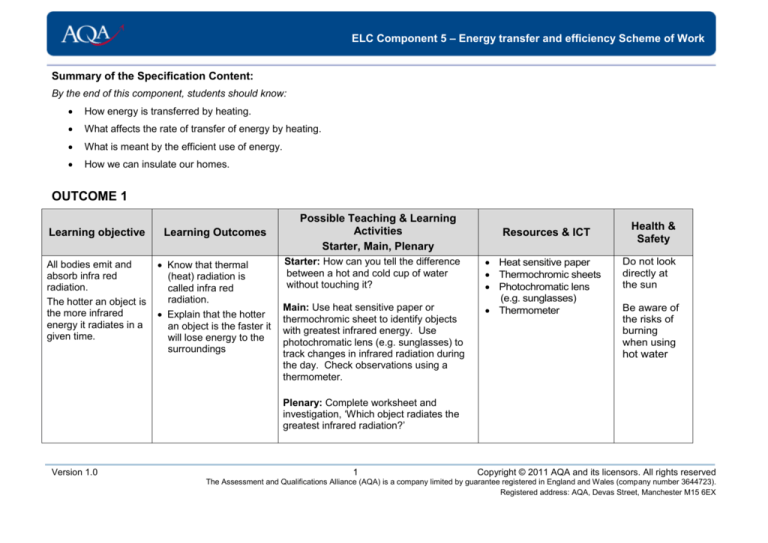
ELC Component 5 – Energy transfer and efficiency Scheme of Work
Summary of the Specification Content:
By the end of this component, students should know:
How energy is transferred by heating.
What affects the rate of transfer of energy by heating.
What is meant by the efficient use of energy.
How we can insulate our homes.
OUTCOME 1
Learning objective
Learning Outcomes
All bodies emit and
absorb infra red
radiation.
The hotter an object is
the more infrared
energy it radiates in a
given time.
Know that thermal
(heat) radiation is
called infra red
radiation.
Explain that the hotter
an object is the faster it
will lose energy to the
surroundings
Possible Teaching & Learning
Activities
Starter, Main, Plenary
Starter: How can you tell the difference
between a hot and cold cup of water
without touching it?
Main: Use heat sensitive paper or
thermochromic sheet to identify objects
with greatest infrared energy. Use
photochromatic lens (e.g. sunglasses) to
track changes in infrared radiation during
the day. Check observations using a
thermometer.
Resources & ICT
Heat sensitive paper
Thermochromic sheets
Photochromatic lens
(e.g. sunglasses)
Thermometer
Health &
Safety
Do not look
directly at
the sun
Be aware of
the risks of
burning
when using
hot water
Plenary: Complete worksheet and
investigation, ‘Which object radiates the
greatest infrared radiation?’
Version 1.0
1
Copyright © 2011 AQA and its licensors. All rights reserved
The Assessment and Qualifications Alliance (AQA) is a company limited by guarantee registered in England and Wales (company number 3644723).
Registered address: AQA, Devas Street, Manchester M15 6EX
ELC Component 5 – Energy transfer and efficiency Scheme of Work
OUTCOME 2
Learning objective
Learning Outcomes
Dark, matt surfaces
are good absorbers
and good emitters of
infra red radiation.
Light, shiny surfaces
are poor absorbers
and poor emitters of
infra red radiation.
Light, shiny surfaces
are good reflectors of
infra red radiation.
Understand the
meaning of the terms
‘absorb’ and ‘emit’.
Describe how the
nature of the surface
determines how good
and absorber or emitter
it is.
Realise that whether an
object emits or absorbs
infra red radiation
depends on whether it
is hotter or colder than
its surroundings.
Understand that infra
red radiation can be
reflected in the same
way as light radiation.
Version 1.0
Possible Teaching & Learning Activities
Starter, Main, Plenary
Starter: Why do people in some hot countries paint
their houses white?
Main: Explain the difference between absorption and
emission
Illustrate with some examples.
Demonstrate infrared radiation being reflected in a
concave mirror.
Resources & ICT
Health &
Safety
A good website to
start with is
http://www.gcsescie
nce.com/pen10matt-black.htm
Plenary: What would be the best colour to paint the
radiators in your home – and why aren’t they painted
this colour?
2
Copyright © 2011 AQA and its licensors. All rights reserved
The Assessment and Qualifications Alliance (AQA) is a company limited by guarantee registered in England and Wales (company number 3644723).
Registered address: AQA, Devas Street, Manchester M15 6EX
ELC Component 5 – Energy transfer and efficiency Scheme of Work
OUTCOME 3
Learning objective
Learning Outcomes
The use of kinetic
theory to explain the
different states of
matter.
The particles of solids,
liquids and gases
have different
amounts of energy.
Explain the differences
between solids, liquids
and gases in terms of
the arrangement of
particles
Describe how by adding
or removing energy,
materials can be made
to change their state.
Version 1.0
Possible Teaching & Learning Activities
Starter, Main, Plenary
Resources & ICT
Starter: Why does friction burn? (More energy
applied = greater the temperature; e.g. rubbing your
hands together)
http://esfscience.wo
rdpress.com/2009/0
9/27/kinetic-theorysummary-for-y9/
Health &
Safety
.
Main: States of matter (water). Use the kinetic
theory model to explain the different states of matter
of water.
Plenary: Issue worksheet with drawings of particles
in solids liquids and gases. Students to label each
one.
3
Copyright © 2011 AQA and its licensors. All rights reserved
The Assessment and Qualifications Alliance (AQA) is a company limited by guarantee registered in England and Wales (company number 3644723).
Registered address: AQA, Devas Street, Manchester M15 6EX
ELC Component 5 – Energy transfer and efficiency Scheme of Work
OUTCOME 4
Learning
objective
Learning
Outcomes
Possible Teaching & Learning Activities
Starter, Main, Plenary
The transfer of
energy by
conduction,
convection,
evaporation
and
condensation
involves
particles.
Be able to identify
which method of
energy transfer
(conduction,
radiation,
convection,
evaporation or
condensation is
involved in a given
situation.
Know that of all
these processes,
only radiation does
not involve particles
of matter.
Know that
convection can only
occur in liquids or
gases.
Starter: Why do saucepans have wooden handles? How do
some birds stay in the air without flapping their wings? How is the
grass wet (dew) on a sunny morning?
Version 1.0
Main: Energy transfer using examples of conduction, convection
and condensation.
Conduction: metal spoon v wooden spoon in hot water
Convection: tissue paper rises over hot radiator
Condensation: ice cold container in a warm room collects
condensation on its surface
Resources & ICT
Health
&
Safety
A good interactive web site
is
http://www.wisconline.com/Objects/ViewObj
ect.aspx?ID=SCE304
and this BBC site contains a
video sequence
http://www.bbc.co.uk/learnin
gzone/clips/conductionconvection-andradiation/10589.html
Plenary:
4
Copyright © 2011 AQA and its licensors. All rights reserved
The Assessment and Qualifications Alliance (AQA) is a company limited by guarantee registered in England and Wales (company number 3644723).
Registered address: AQA, Devas Street, Manchester M15 6EX
ELC Component 5 – Energy transfer and efficiency Scheme of Work
OUTCOME 5
Learning
objective
The factors
that affect the
rate of
evaporation
and
condensation.
Version 1.0
Possible Teaching & Learning Activities
Starter, Main, Plenary
Learning
Outcomes
Identify variables
that affect the rate
of evaporation and
condensation, i.e.
- temperature
- wind
- surface area
Starter: How does evaporation help cool you down?
Main: Factors which change the rate of evaporation and
condensation (e.g. difference between liquid and air temperature;
surface area/volume; type of material
Plenary: How would you get washing to dry as fast as possible?
5
Resources & ICT
Health &
Safety
There is a nice little
YouTube video on
http://www.youtube.com/wat
ch?v=yyxc-81JDbo
and a worksheet at this site
http://www.primaryresource
s.co.uk/science/pdfs/RDeva
p.pdf
Copyright © 2011 AQA and its licensors. All rights reserved
The Assessment and Qualifications Alliance (AQA) is a company limited by guarantee registered in England and Wales (company number 3644723).
Registered address: AQA, Devas Street, Manchester M15 6EX
ELC Component 5 – Energy transfer and efficiency Scheme of Work
OUTCOME 6
Learning objective
Learning Outcomes
The rate at which an
object transfers energy
by heating depends on:
• surface area
• the material from
which the object is
made
• the nature of the
surface with which the
object is in contact.
Recall factors that
affect the rate at which
an object transfers
energy by heating.
Version 1.0
Possible Teaching & Learning Activities
Starter, Main, Plenary
Starter: Show students a heat sink from a transistor
or microchip and ask why it is designed in that way.
Main: Discuss the design of the fins. Use other
examples, e.g. car radiators and motor bike engines.
Resources & ICT
Health &
Safety
A website that teachers
might find useful is
http://www.physicsclassroo
m.com/class/thermalP/u18l1
f.cfm
Plenary: How does a heat-proof mat under a Bunsen
burner reduce the rate at which thermal energy is
transferred to the bench?
6
Copyright © 2011 AQA and its licensors. All rights reserved
The Assessment and Qualifications Alliance (AQA) is a company limited by guarantee registered in England and Wales (company number 3644723).
Registered address: AQA, Devas Street, Manchester M15 6EX
ELC Component 5 – Energy transfer and efficiency Scheme of Work
OUTCOME 7
Learning objective
Learning Outcomes
The bigger the
temperature difference
between an object and
its surroundings, the
faster the rate at which
energy is transferred
by heating.
State that the hotter an
object is, the faster it
will transfer thermal
energy to the
surroundings.
Version 1.0
Possible Teaching & Learning Activities
Starter, Main, Plenary
Resources & ICT
Health &
Safety
Starter: What happens to the temperature of a hot
cup of tea on a hot, mild and cold day?
Main: Discus whether the temperature of the
surroundings affects how quickly a liquid cools
down.
Plenary: Issue a work sheet showing objects at
different temperatures in surroundings of different
temperatures. Which will transfer energy the fastest?
7
Copyright © 2011 AQA and its licensors. All rights reserved
The Assessment and Qualifications Alliance (AQA) is a company limited by guarantee registered in England and Wales (company number 3644723).
Registered address: AQA, Devas Street, Manchester M15 6EX
ELC Component 5 – Energy transfer and efficiency Scheme of Work
OUTCOME 8
Learning objective
Learning Outcomes
Heating and insulating buildings.
U-values measure how effective
a material is as an insulator.
The lower the U-value, the better
the material is as an insulator.
Identify different ways of
insulating buildings,
e.g.:
- fibre glass insulation
for roofs
- foam insulation for
cavity walls
- carpet and underlay
for floors
- draught excluders for
gaps
Recall that the lower the
U-value of a material,
the better it is at
insulating.
Version 1.0
Possible Teaching & Learning
Activities
Starter, Main, Plenary
Starter: Ask “How many ways can you
think of that heat (thermal energy) can be
lost from your home?”
Main: Issue a diagram of a house showing
the different ways in which energy can be
lost.
Discuss the different ways of reducing each
loss.
Remember that turning down the
thermostat is just as effective as spending
money on insulation in some cases.
Explain the idea of U-values.
Resources & ICT
Health &
Safety
A useful website is
http://www.energysavingtr
ust.org.uk/Homeimprovements-andproducts/Homeinsulation-glazing
Plenary: If you have very little money to
spend on home insulation, which sort
would you fit first and why?
8
Copyright © 2011 AQA and its licensors. All rights reserved
The Assessment and Qualifications Alliance (AQA) is a company limited by guarantee registered in England and Wales (company number 3644723).
Registered address: AQA, Devas Street, Manchester M15 6EX
ELC Component 5 – Energy transfer and efficiency Scheme of Work
OUTCOME 9
Learning objective
Learning Outcomes
When energy is
transferred, only part of it
may be usefully
transferred, the rest is
wasted.
Wasted energy is
eventually transferred to
the surroundings, which
become warmer.
The wasted energy
becomes increasingly
spread out and so
becomes less useful.
Understand that not all of
the input energy in a
situation is transferred into
the intended place or
becomes the intended type
of energy.
Explain that wasted energy
often goes into warming up
the surroundings.
Realise that as the energy
becomes more spread out
in the surroundings it
becomes more difficult to
use and so less useful
Version 1.0
Possible Teaching & Learning Activities
Starter, Main, Plenary
Resources & ICT
Health &
Safety
Starter: Name the ‘useful’ and ‘wasted’ energy
in a list of ‘energy transfers’
A website that gives one
perspective on energy
Main: Discuss different types of energy and
wastage is
energy transfers.
http://wwf.panda.org/about
Look at energy saving labels from domestic
_our_earth/aboutcc/cause/
appliances, e.g. fridges. Why do some use
wasting_energy_eff/
more energy than others?
Plenary: Why is it important that energy is not
wasted?
9
Copyright © 2011 AQA and its licensors. All rights reserved
The Assessment and Qualifications Alliance (AQA) is a company limited by guarantee registered in England and Wales (company number 3644723).
Registered address: AQA, Devas Street, Manchester M15 6EX
ELC Component 5 – Energy transfer and efficiency Scheme of Work
OUTCOME 10
Learning
objective
Learning
Outcomes
The greater the
percentage of the
energy that is
usefully transformed
in a device, the
more efficient the
device is, eg the
comparison
between filament
lamps and
fluorescent tubes.
Explain that
efficient devices
are those that
change more of
the input energy
into the
intended, useful
form of energy.
Version 1.0
Possible Teaching & Learning Activities
Starter, Main, Plenary
Starter: How do electrical appliances waste energy?
Main: Evaluate the efficiency of different electrical
appliances e.g. filament lamps and fluorescent tubes
Plenary: Is it possible for a device to be more than 100%
efficient?
10
Resources & ICT
Health &
Safety
A good website for energy
efficiency is
http://www.npower.com/Home/
Energy-efficiency/Savingenergy/Efficientproducts/index.htm
Copyright © 2011 AQA and its licensors. All rights reserved
The Assessment and Qualifications Alliance (AQA) is a company limited by guarantee registered in England and Wales (company number 3644723).
Registered address: AQA, Devas Street, Manchester M15 6EX



